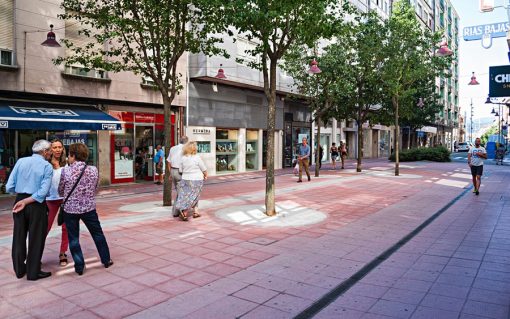 To many, this phrase defines the contribution of the city of Pontevedra to the development of an alternative city model, but its meaning goes much further. Of course, there are still cars driving around Pontevedra, but only those that are absolutely necessary.
To many, this phrase defines the contribution of the city of Pontevedra to the development of an alternative city model, but its meaning goes much further. Of course, there are still cars driving around Pontevedra, but only those that are absolutely necessary.
Our model defends the idea that the total number of cars that are needed for the city to function properly is far lower than people think.
Emergency services, transport of supplies, access to private parking and commercial spaces, delivery of heavy freights, transfers of disabled people… the city must make sure that urban mobility is as efficient and dynamic as to cater for a diversity of needs: from residents in the city center to workers who are just passing through.
Suppressing indiscriminate parking in central streets is one of the key measures that makes it possible to mitigate the effects of traffic jams and the abuse of the passenger car.
Priorities
Conventional city models focus their attention on private motorized vehicles, while pedestrians are almost completely ignored.
Pontevedra has placed pedestrians (and wheelchair users) at the top of the mobility hierarchy, followed by bicycles, public transport and, lastly, private cars.
Types of traffic
Pontevedra’s pedestrian city model considers three different types of motorized traffic:
- Destination traffic. Drivers who are using certain streets to reach other streets.
- Search traffic. Drivers who are looking for a place to park and, due to the scarcity of spaces in conventional urban mobility models, rarely find it.
- Through-traffic. Drivers who are trying to reach a private parking space or the intended end of their journey.
The new mobility model encourages destination traffic and prevents search and through-traffic with the enforcement of active dissuasive measures.
Stop shortcuts
Suppressing shortcuts that allow car owners to flood the city center or a given neighborhood with private passenger vehicles has proved to be very efficient in reducing traffic density. In the Historic Center of Pontevedra, for instance, destination traffic is permitted if drivers use the authorized points of entry and exit; therefore, shortcuts are discouraged.
Parking networks
Search traffic may be prevented by regulating indiscriminate parking. Most streets in the inner ring are under constant police surveillance and follow a free-of-charge service-focused parking scheme.
There are about 3,500 parking spaces available free of charge throughout the perimeter of the inner ring –a 10-minute walk from the center– and almost 4,500 underground paid parking spaces in the city.
Deliveries
Transport and courier services follow the designated morning and afternoon timetables to deliver goods to pedestrianized areas efficiently and effectively.




